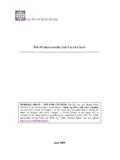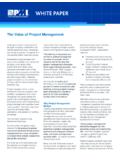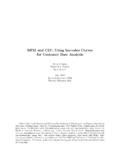Transcription of C o n stru ctive P lay - Institute For Self Active Education
1 Young Children July 20082, 3 Constructive PlayA value -Added Strategy for Meeting Early Learning StandardsCONSTRUCTIVE PLAY INVOLVES building and making things no one has ever seen before. As young children fiddle with, sort, and arrange materials, ideas and imagination begin to flow. Questions arise naturally. They wonder: What will happen if I put this here? How tall will it go? Where did the bubble come from? In this way, constructive play serves to focus the minds of children through their fingertips and leads them to invent and discover new possibilities, to fulfill their sense of in a standards-oriented world In many early childhood programs across the country, time for play is dwindling away.
2 The field of early childhood Education is in the midst of a major shift in orientation toward a standards base. Early learning standards specify what young children should know and be able to do in academic areas such as sci-ence, literacy, and mathematics. These standards have rapidly become an integral part of state systems of early childhood edu-cation. All the states plus the District of Columbia have approved early learning standards for preschoolers. As a structural ele-ment of Education reform, early learning standards shape the content of instructional curriculum, set the goals of professional development, and establish the focus of outcomes assessment.
3 Standards are increasingly seen as a powerful lever for improving preschool instruction and children s school F. Drew, James Christie, James E. Johnson, Alice M. Meckley, and Marcia L. NellWalter F. Drew, EdD, is executive director of the Institute for Self- Active Education and cofounder of the Reusable Resources Association. He chairs the Play Committee for the Early Childhood Association of Florida and is creator of Dr. Drew s Discovery Blocks. Christie, PhD, is a professor of curricu-lum and instruction at Arizona State University in Phoenix.
4 He is past president of the Association for the Study of Play and a member of the board of directors of Playing for Keeps. E. Johnson, PhD, is professor-in-charge of early childhood Education at Penn State Uni-versity in University Park. He is the current series editor of Play and Cultural Studies and the former president of the Association for the Study of M. Meckley, PhD, professor in early child-hood Education at Millersville University, Pennsyl-vania, researches the social play of young chil-dren. She is a member of the NAEYC Play, Policy, and Practice Interest Forum s Research Group and TASP (The Association for the Study of Play).
5 L. Nell, PhD, is assistant professor in the Elementary and Early Childhood Department at Millersville University. Marcia has been a public school teacher for 25 years in kindergarten through second grade Trisha McCunn38 This was one of the children s first days using turkey basters in water play. We try to add only one new thing at a time. The children started hooking the funnel to the turkey baster and found ways to fill the baster and squirt out water. They were so excited to discover they had made a fountain. They named it Water Spout.
6 We had read the book I Wish that I Had Duck Feet, and the children remembered the water spout in the story. Trisha McCunn, Preschool TeacherYoung Children July 200839 This rise of state early learning standards has alarmed many early childhood educators, especially advocates of play-based approaches to teaching and learning. Play has long had a central role in early childhood Education , where it has been viewed as an effective means for promoting all aspects of child development. Many early childhood teach-ers are concerned that the standards movement and its narrowing of educational goals are pushing aside classroom learning through play in favor of more didactic forms of play and standards In this article, we take a more positive, pragmatic approach and propose to reconcile constructive play with the standards movement.
7 Recognizing that standards have become an integral part of early Education , we believe that mature forms of play, such as the examples presented in which children are focused and intentional, can be effec-tive strategies for helping children learn academic skills stressed in state standards (Kagan & Lowenstein 2004; Van Thiel & Putnam-Franklin 2004; Christie & Roskos 2006). Mature play is mindful make-believe and reasonably self-regulated. Our proposals are based on field research, observations, interviews, and vignettes focused on constructive play that uses a variety of open-ended materials to promote learn-ing and development.
8 We share educators stories, experi-ences, and ideas around principles of constructive play and include specific suggestions for principles for using constructive play to meet early learning standards We identify three key principles that explain why devel-opmentally appropriate constructive play is an ideal instructional strategy for meeting early learning standards. These principles are derived from our own experiences as play researchers and teacher During the preschool years, constructive play merges with exploration and make-believe play and becomes a mature form of play that allows children to strengthen inquiry skills and build conceptual understanding.
9 Constructive play is organized, goal-oriented play in which children use play materials to create or build some-thing (Johnson, Christie, & Wardle 2005). It often begins during the toddler years and becomes increasingly complex with age. Constructive play involves open-ended explora-tion, gradually becoming more functional in nature, then evolving to make-believe transformations. Four- and 5-year-olds often switch back and forth between constructive and dramatic play, and it can be difficult to distinguish between the two forms of play. According to Bodrova and Leong (2004), the type of mature play that promotes learning and development has three critical components: imaginary situ-ations, explicit roles, and implicit rules.
10 We typically think of constructive play as building with blocks and other three-dimensional materials. Building a road or castle with wooden blocks, shaping a ball out of Penny Feeney Walter F. DrewMature play has three critical components: imaginary situ-ations, explicit roles, and implicit Children July 2008clay, constructing a spaceship with recycled materials, and putting a puzzle together are all examples of constructive play. But how is the water play, described at the beginning of this article, constructive play (see Water Play below)?






